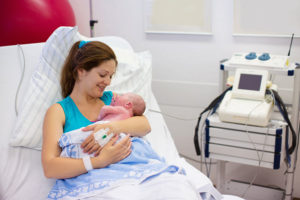
Childbirth progresses in three main stages: labor, delivery of the baby and delivery of the placenta. The first stage of childbirth (labor) begins when the cervix starts to open, allowing the baby to move down the birth canal when it’s fully dilated. At this point, the contractions have opened up the neck of the uterus to 10 centimeters. This is usually the longest stage of labor and can take up to 20 hours. This labor stage is divided into three additional phases: early, active and transitional. The phases of labor differ from one mother to another and one pregnancy to another. Knowledge can be comforting; read on for what to expect during the three phases of stage one of childbirth labor.
Early Phase of Labor
This phase is the longest of the three but not as intense as the other two phases. During early labor, the cervix opens and widens. It may start from zero centimeters to three or four centimeters. The contractions are usually very mild, more like mild cramps that you get during your period. Most mothers, especially first-timers, may not even notice the changes. For most mothers, early labor is not uncomfortable and they prefer experiencing it within the comforts of their homes. Once the contractions start increasing in frequency and intensity, it is advisable to go to the hospital or have your childbirth attendant around. In the meantime, you may continue engaging in some activities that will help you relax. However, take note of the time contractions started and continue to monitor them every 30 minutes. In this phase, contractions may roughly start after every seven minutes and last approximately 40 seconds. This phase may end when the cervix is three centimeters dilated and when the contractions become more intense. This early phase of labor may last for eight hours or more.
Active Phase of Labor
During this phase, the contractions are likely to get longer and more frequent. Contractions become more intense and painful before they fade away. They may be three to four minutes apart and last for 60 to 90 seconds. Contractions in this phase tend to maintain their frequency and intensity as they open your cervix more, from three to four centimeters to seven centimeters. It may take a few hours before the cervix becomes fully dilated, and this active phase can typically be expected to last three to four hours, but it can also take longer or less time. Apply relaxation techniques to keep you calm as the labor progresses. In between contractions you may move around to prepare yourself for the next contraction. In active labor make sure you are close to your place of birth, or your midwife is with you if you are planning to deliver at home.
Transitional Phase of Labor
 This is the last phase of labor and starts when the cervix is eight centimeters dilated to when it’s fully dilated, at 10 centimeters or when you feel like pushing. It is the phase where your labor pain will be at its worst. The contractions may reduce in frequency but are much stronger and last longer. During this time, the contractions may feel like they are immediately following each other. These muscular contractions help to push your baby further down the cervix. It’s common for the water to break before or during the transition. This phase may last for 10 minutes or an hour and throughout the entire time you will be in your specified birthing position. No one can predict how long their specific childbirth will take or how painful or less painful it will be compared to others’. However, reading about labor prepares you on what to expect as the events unfold but until you have gone through it for yourself, having a general idea of what could take place is the closest you can prepare yourself for what is to come.
This is the last phase of labor and starts when the cervix is eight centimeters dilated to when it’s fully dilated, at 10 centimeters or when you feel like pushing. It is the phase where your labor pain will be at its worst. The contractions may reduce in frequency but are much stronger and last longer. During this time, the contractions may feel like they are immediately following each other. These muscular contractions help to push your baby further down the cervix. It’s common for the water to break before or during the transition. This phase may last for 10 minutes or an hour and throughout the entire time you will be in your specified birthing position. No one can predict how long their specific childbirth will take or how painful or less painful it will be compared to others’. However, reading about labor prepares you on what to expect as the events unfold but until you have gone through it for yourself, having a general idea of what could take place is the closest you can prepare yourself for what is to come.


